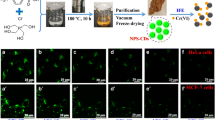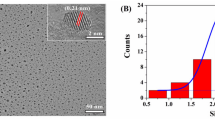Abstract
Water-soluble nitrogen-doped carbon quantum dots (C-dots) were fabricated by microwave-induced decomposition of the precursor materials citric acid and N,N′-bis(2-aminoethyl)-1,2-ethanediamine. The C-dots were placed on portable paper strips with novel origami designs to simplified user operations. The intensity of the blue fluorescence, best measured at excitation/emission wavelengths of 330/420 nm, depends on the pH value in the range from pH 2 to 12. The C-dots on the paper stripe are shown to be a sensitive fluorescent probe for chromium(VI) via an inner filter effect. Response is linear in the 0.08 to 1 mM concentration range, and the detection limit (at S/N = 3) is 0.14 mM. The test was applied to the determination of chromium(VI) in (spiked) environmental water samples.

Schematic presentation of the water-soluble nitrogen-doped carbon dots (C-dots) as a fluorescent probe for Cr6+ based on an inner filter effect. The three-dimensional paper analytical device integrating C-dots was applied to the determination of Cr6+ in (spiked) environmental water samples.




Similar content being viewed by others
References
Li S, Huang J, Chen Z, Chen G, Lai Y (2017) A review on special wettability textiles: theoretical models, fabrication technologies and multifunctional applications. J Mater Chem A 5(1):31–55
Chen G-H, Chen W-Y, Yen Y-C, Wang C-W, Chang H-T, Chen C-F (2014) Detection of mercury (II) ions using colorimetric gold nanoparticles on paper-based analytical devices. Anal Chem 86(14):6843–6849
Faham S, Khayatian G, Golmohammadi H, Ghavami R (2018) A paper-based optical probe for chromium by using gold nanoparticles modified with 2,2-thiodiacetic acid and smartphone camera readout. Microchim Acta 185(8):374
Chatterjee S, Sinha Mahapatra P, Ibrahim A, Ganguly R, Yu L, Dodge R, Megaridis C (2018) Precise liquid transport on and through thin porous materials. Langmuir 34(8):2865–2875
Zang D, Ge L, Yan M, Song X, Yu J (2012) Electrochemical immunoassay on a 3D microfluidic paper-based device. Chem Commun 48(39):4683–4685
Yan J, Ge L, Song X, Yan M, Ge S, Yu J (2012) Paper-based Electrochemiluminescent 3D Immunodevice for lab-on-paper, specific, and sensitive point-of-care testing. Chem Eur J 18(16):4938–4945
Qu S, Wang X, Lu Q, Liu X, Wang L (2012) A biocompatible fluorescent ink based on water-soluble luminescent carbon nanodots. Angew Chem Int Edit 51(49):12215–12218
Jiang J, He Y, Li S, Cui H (2012) Amino acids as the source for producing carbon nanodots: microwave assisted one-step synthesis, intrinsic photoluminescence property and intense chemiluminescence enhancement. Chem Commun 48(77):9634–9636
Zhang J, Chen X, Li Y, Han S, Du Y, Liu H (2018) A nitrogen doped carbon quantum dot-enhanced chemiluminescence method for the determination of Mn2+. Anal Methods 10(5):541–547
Zhou L, Lin Y, Huang Z, Ren J, Qu X (2012) Carbon nanodots as fluorescence probes for rapid, sensitive, and label-free detection of Hg2+ and biothiols in complex matrices. Chem Commun 48(8):1147–1149
Sha Y, Lou J, Bai S, Wu D, Liu B, Ling Y (2013) Hydrothermal synthesis of nitrogen-containing carbon nanodots as the high-efficient sensor for copper (II) ions. Mater Res Bull 48(4):1728–1731
Qu K, Wang J, Ren J, Qu X (2013) Carbon dots prepared by hydrothermal treatment of dopamine as an effective fluorescent sensing platform for the label-free detection of iron (III) ions and dopamine. Chem Eur J 19(22):7243–7249
Kumar A, Chowdhuri AR, Laha D, Mahto TK, Karmakar P, Sahu SK (2017) Green synthesis of carbon dots from Ocimum sanctum for effective fluorescent sensing of Pb2+ ions and live cell imaging. Sensors Actuators B Chem 242:679–686
Amjadi M, Manzoori JL, Hallaj T, Sorouraddin MH (2014) Strong enhancement of the chemiluminescence of the cerium(IV)-thiosulfate reaction by carbon dots, and its application to the sensitive determination of dopamine. Microchim Acta 181(5):671–677
Zuo P, Lu X, Sun Z, Guo Y, He HJ (2016) A review on syntheses, properties, characterization and bioanalytical applications of fluorescent carbon dots. Microchim Acta 183(2):519–542
Nagajyoti P, Lee K, Sreekanth T (2010) Heavy metals, occurrence and toxicity for plants: a review. Environ Chem Lett 8(3):199–216
Oliveira H (2012). Chromium as an environmental pollutant: insights on induced plant toxicity. J Bot 2012
Plechkova NV, Seddon KR (2008) Applications of ionic liquids in the chemical industry. Chem Soc Rev 37(1):123–150
Nriagu JO (1988) Production and uses of chromium. Chromium in the natural human environments 20:81–104
Williams C, David DJ, Iismaa OJT (1962) The determination of chromic oxide in faeces samples by atomic absorption spectrophotometry. J Agric Sci 59(3):381–385
Sperling M, Xu S, Welz B (1992) Determination of chromium (III) and chromium (VI) in water using flow injection on-line preconcentration with selective adsorption on activated alumina and flame atomic absorption spectrometric detection. Anal Chem 64(24):3101–3108
Barnowski C, Jakubowski N, Stuewer D, Broekaert JA (1997) Speciation of chromium by direct coupling of ion exchange chromatography with inductively coupled plasma mass spectrometry. J Anal Atom Spectrom 12(10):1155–1161
Hirata S, Honda K, Shikino O, Maekawa N, Aihara MJSAPBAS (2000) Determination of chromium (III) and total chromium in seawater by on-line column preconcentration inductively coupled plasma mass spectrometry. Spectrochim Acta B 55(7):1089–1099
Jung JY, Han SJ, Chun J, Lee C, Yoon J (2012) New thiazolothiazole derivatives as fluorescent chemosensors for Cr3+ and Al3+. Dyes Pigments 94(3):423–426
Wan Y, Guo Q, Wang X, AJAca X (2010) Photophysical properties of rhodamine isomers: a two-photon excited fluorescent sensor for trivalent chromium cation (Cr3+). Anal Chim Acta 665(2):215–220
Zhou Y, Zhang J, Zhang L, Zhang Q, Ma T, Niu J (2013) A rhodamine-based fluorescent enhancement chemosensor for the detection of Cr3+ in aqueous media. Dyes Pigments 97(1):148–154
Zheng M, Xie Z, Qu D, Li D, Du P, Jing X, Sun Z (2013) On–off–on fluorescent carbon dot nanosensor for recognition of chromium (VI) and ascorbic acid based on the inner filter effect. ACS Appl Mater Interfaces 5(24):13242–13247
Hallam PM, Kampouris DK, Kadara RO, Banks CE (2010) Graphite screen printed electrodes for the electrochemical sensing of chromium (VI). Analyst 135(8):1947–1952
Jena BK, Raj CRJT (2008) Highly sensitive and selective electrochemical detection of sub-ppb level chromium (VI) using nano-sized gold particle. Talanta 76(1):161–165
Kochmann S, Hirsch T, Wolfbeis OS (2012) The pH dependence of the total fluorescence of graphite oxide. J Fluoresc 22(3):849–855
Qu S, Chen H, Zheng X, Cao J, Liu X (2013) Ratiometric fluorescent nanosensor based on water soluble carbon nanodots with multiple sensing capacities. Nanoscale 5(12):5514–5518
Mohan D, Pittman CU (2006) Activated carbons and low cost adsorbents for remediation of tri- and hexavalent chromium from water. J Hazard Mater 137(2):762–811
Bu L, Peng J, Peng H, Liu S, Xiao H, Liu D, Pan Z, Chen Y, Chen F, He Y (2016) Fluorescent carbon dots for the sensitive detection of Cr(vi) in aqueous media and their application in test papers. RSC Adv 6(98):95469–95475
Pacquiao MR, de Luna MDG, Thongsai N, Kladsomboon S, Paoprasert P (2018) Highly fluorescent carbon dots from enokitake mushroom as multi-faceted optical nanomaterials for Cr6+ and VOC detection and imaging applications. Appl Surf Sci 453:192–203
Apilux A, Dungchai W, Siangproh W, Praphairaksit N, Henry CS, Chailapakul O (2010) Lab-on-paper with dual electrochemical/colorimetric detection for simultaneous determination of gold and iron. Anal Chem 82(5):1727–1732
Ge L, Wang S, Song X, Ge S, Yu J (2012) 3D origami-based multifunction-integrated immunodevice: low-cost and multiplexed sandwich chemiluminescence immunoassay on microfluidic paper-based analytical device. Lab Chip 12(17):3150–3158
Acknowledgements
This work was funded by the Ministry of Science and Technology of Taiwan under the project number 107-2113-M-003-013-MY3. We thank Yi-Ju Chou for helpful discussions.
Author information
Authors and Affiliations
Corresponding authors
Ethics declarations
The author(s) declare that they have no competing interests.
Additional information
Publisher’s note
Springer Nature remains neutral with regard to jurisdictional claims in published maps and institutional affiliations.
Electronic supplementary material
ESM 1
(PDF 1.07 mb)
Rights and permissions
About this article
Cite this article
Lu, KH., Lin, JH., Lin, CY. et al. A fluorometric paper test for chromium(VI) based on the use of N-doped carbon dots. Microchim Acta 186, 227 (2019). https://doi.org/10.1007/s00604-019-3337-5
Received:
Accepted:
Published:
DOI: https://doi.org/10.1007/s00604-019-3337-5




